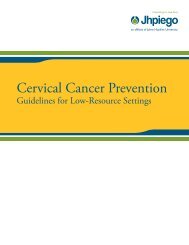Manual for Male Circumcision under Local Anaesthesia
Manual for Male Circumcision under Local Anaesthesia
Manual for Male Circumcision under Local Anaesthesia
You also want an ePaper? Increase the reach of your titles
YUMPU automatically turns print PDFs into web optimized ePapers that Google loves.
<strong>Male</strong> circumcision <strong>under</strong> local anaesthesia<br />
Version 3.1 (Dec09)<br />
PAEDIATRIC SURGICAL METHODS<br />
Four techniques <strong>for</strong> circumcision of children are described in<br />
this section: the dorsal slit method, the Plastibell method, the<br />
Mogen clamp method, and the Gomco clamp method.<br />
The dorsal slit method with closure of the wound with suture is<br />
not typically used <strong>for</strong> infant male circumcision and is more<br />
appropriate <strong>for</strong> older children, particularly in situations where<br />
the surgeon <strong>under</strong>takes relatively few procedures so that it is<br />
not practical to stock devices. A small dorsal slit is a<br />
preliminary step when using the Gomco and Plastibell devices.<br />
Typically, in early infancy, the wound does not need to be<br />
closed with sutures, regardless of the device used.<br />
In babies, the <strong>for</strong>eskin is long in relation to the penis, and there<br />
is little chance of penile erection. This has two important<br />
consequences. First, the glans will be further exposed towards<br />
puberty, as the penis grows relative to the <strong>for</strong>eskin. Second,<br />
clamping devices that remain on the penis <strong>for</strong> a few days (e.g.<br />
the Plastibell device) are more feasible than with adults,<br />
because there is less chance of the device being pushed off by<br />
an erection.<br />
In early infancy (< 60 days of age), regardless of which<br />
technique is used, closure of the wound is typically not<br />
necessary. Beyond early infancy (>60 days) better cosmetic<br />
outcomes may be achieved if the wound is closed with simple<br />
interrupted sutures. The Plastibell provides a unique benefit<br />
over the other techniques in that it can be used outside of the<br />
early infant period without regularly requiring surgical closure.<br />
Extremely rare complications such as loss of the glans, urinary<br />
retention and bladder rupture have been reported with the use<br />
of the Plastibell device as a result of migration of the ring onto<br />
the shaft of the penis, which may happen if the wrong size is<br />
used. The Plastibell should only be considered in areas where<br />
follow up is both reliable and easily available.<br />
The Plastibell is a disposable device, whereas the Mogen and<br />
Gomco clamps are reusable. The choice between the different<br />
techniques may depend on the cost of the Plastibell, the need<br />
to sterilize the Mogen and Gomco clamps, the ages at which<br />
circumcision is per<strong>for</strong>med, and the possible need <strong>for</strong> suturing<br />
skills.<br />
The advantages and disadvantages of the different methods of<br />
paediatric circumcision are summarized in Table 6.2.<br />
Infant and paediatric circumcision Chapter 6 - 7
















